Developing Individuals, Teams, and Organizations: HR Skills Report
VerifiedAdded on 2020/11/23
|15
|3940
|382
Report
AI Summary
This report delves into the crucial skills, knowledge, and behaviors expected of Human Resources professionals, emphasizing the importance of continuous development for both individual and organizational success. It begins by outlining the essential competencies required of an HR officer, including the ability to implement effective policies, promote diversity, and manage various HR functions such as recruitment, training, and performance management. The report then presents a personal skill audit and a professional development plan for a hypothetical HR officer, Jane Cambridge, identifying her strengths and weaknesses and proposing strategies for skill enhancement. Furthermore, the report explores the differences between organizational and individual learning, highlighting the impact of training and development on productivity, talent pool, and employee potential. Finally, it examines the role of continuous learning and professional development in driving sustainable business performance, emphasizing the need for organizations to adapt to changing environments and maintain a skilled workforce to achieve their objectives. The report also touches upon the importance of high-performance work in contributing to employee engagement and competitive advantage, along with different approaches to performance management.
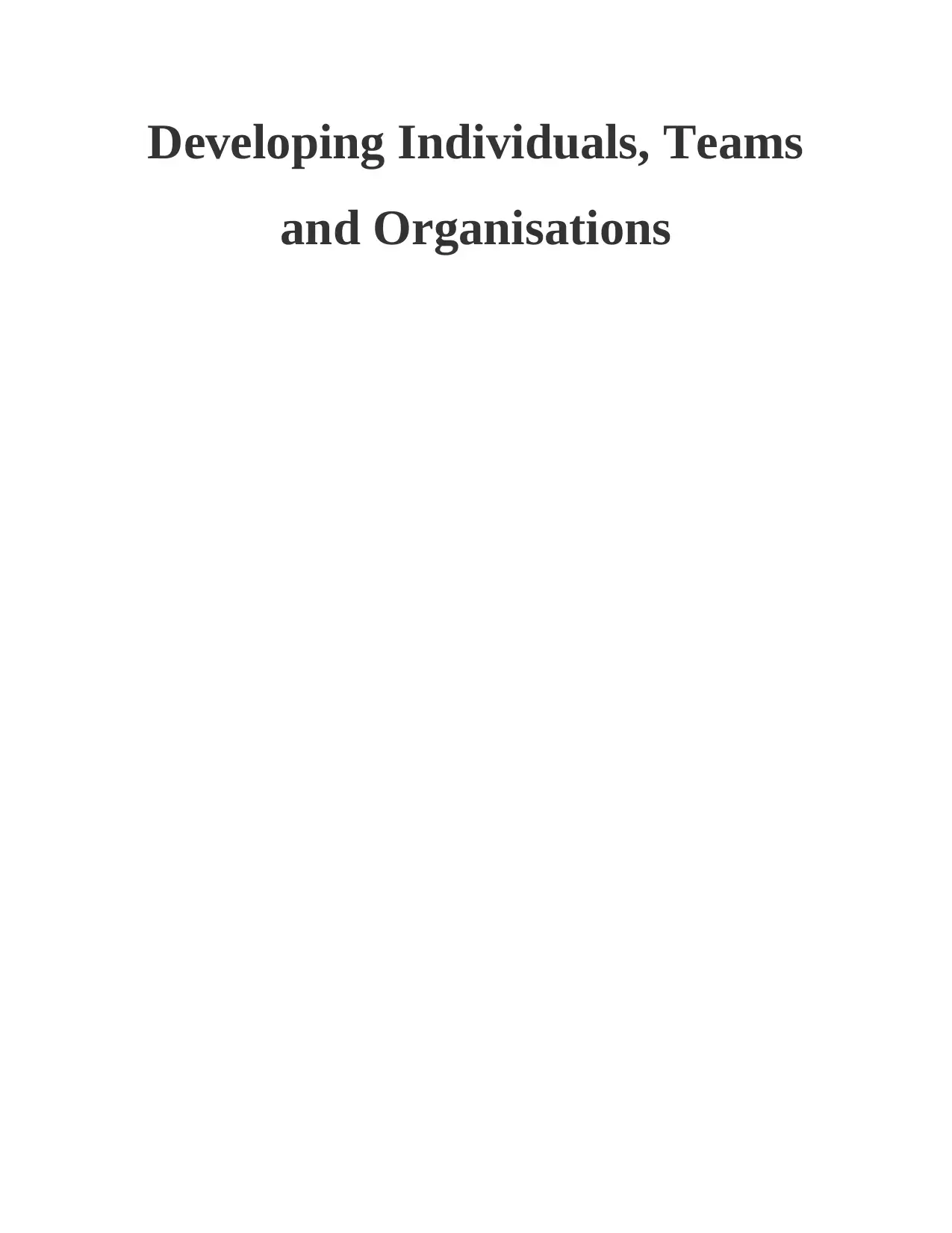
Developing Individuals, Teams
and Organisations
and Organisations
Paraphrase This Document
Need a fresh take? Get an instant paraphrase of this document with our AI Paraphraser
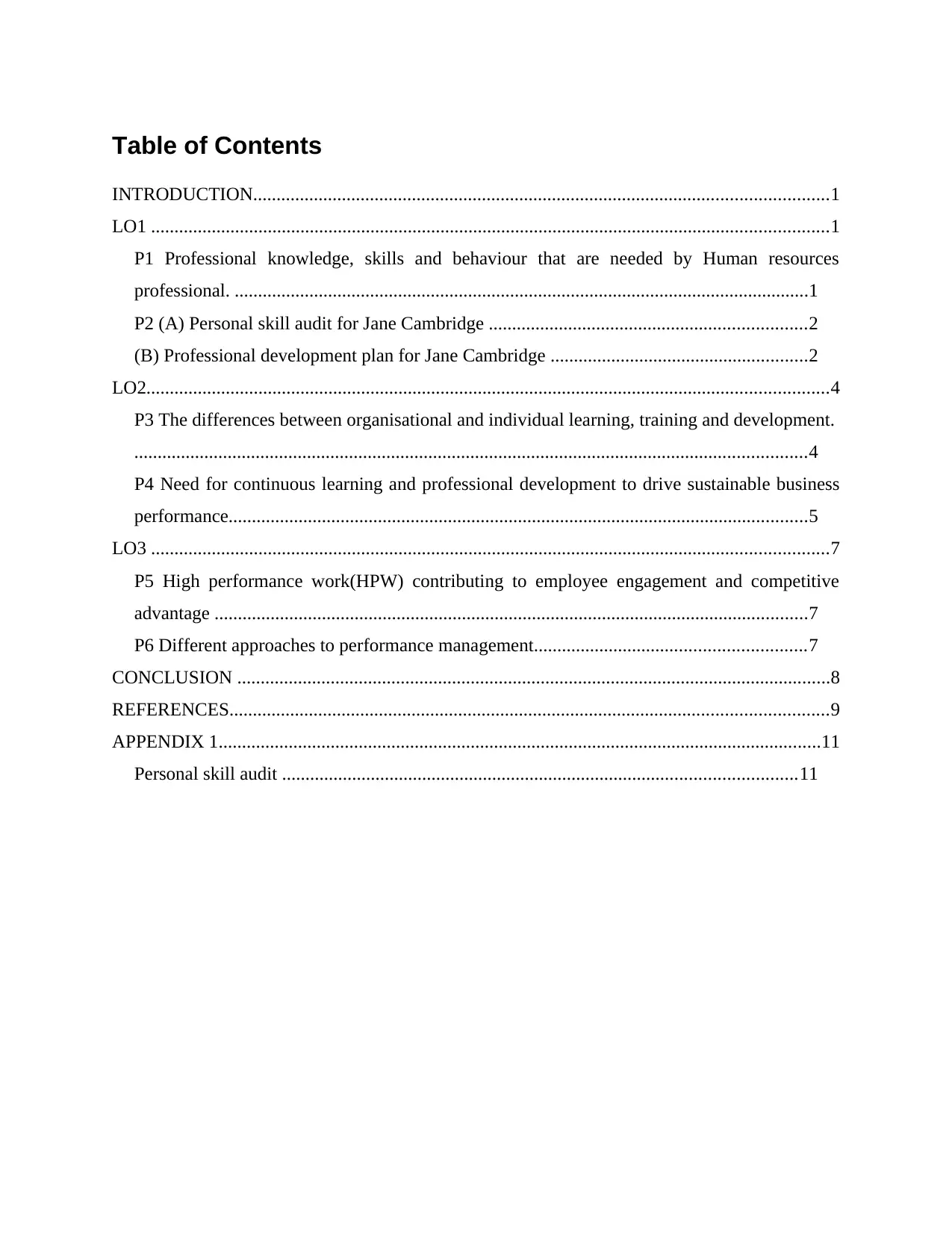
Table of Contents
INTRODUCTION...........................................................................................................................1
LO1 .................................................................................................................................................1
P1 Professional knowledge, skills and behaviour that are needed by Human resources
professional. ...........................................................................................................................1
P2 (A) Personal skill audit for Jane Cambridge ....................................................................2
(B) Professional development plan for Jane Cambridge .......................................................2
LO2..................................................................................................................................................4
P3 The differences between organisational and individual learning, training and development.
................................................................................................................................................4
P4 Need for continuous learning and professional development to drive sustainable business
performance............................................................................................................................5
LO3 .................................................................................................................................................7
P5 High performance work(HPW) contributing to employee engagement and competitive
advantage ...............................................................................................................................7
P6 Different approaches to performance management..........................................................7
CONCLUSION ...............................................................................................................................8
REFERENCES................................................................................................................................9
APPENDIX 1.................................................................................................................................11
Personal skill audit ..............................................................................................................11
INTRODUCTION...........................................................................................................................1
LO1 .................................................................................................................................................1
P1 Professional knowledge, skills and behaviour that are needed by Human resources
professional. ...........................................................................................................................1
P2 (A) Personal skill audit for Jane Cambridge ....................................................................2
(B) Professional development plan for Jane Cambridge .......................................................2
LO2..................................................................................................................................................4
P3 The differences between organisational and individual learning, training and development.
................................................................................................................................................4
P4 Need for continuous learning and professional development to drive sustainable business
performance............................................................................................................................5
LO3 .................................................................................................................................................7
P5 High performance work(HPW) contributing to employee engagement and competitive
advantage ...............................................................................................................................7
P6 Different approaches to performance management..........................................................7
CONCLUSION ...............................................................................................................................8
REFERENCES................................................................................................................................9
APPENDIX 1.................................................................................................................................11
Personal skill audit ..............................................................................................................11
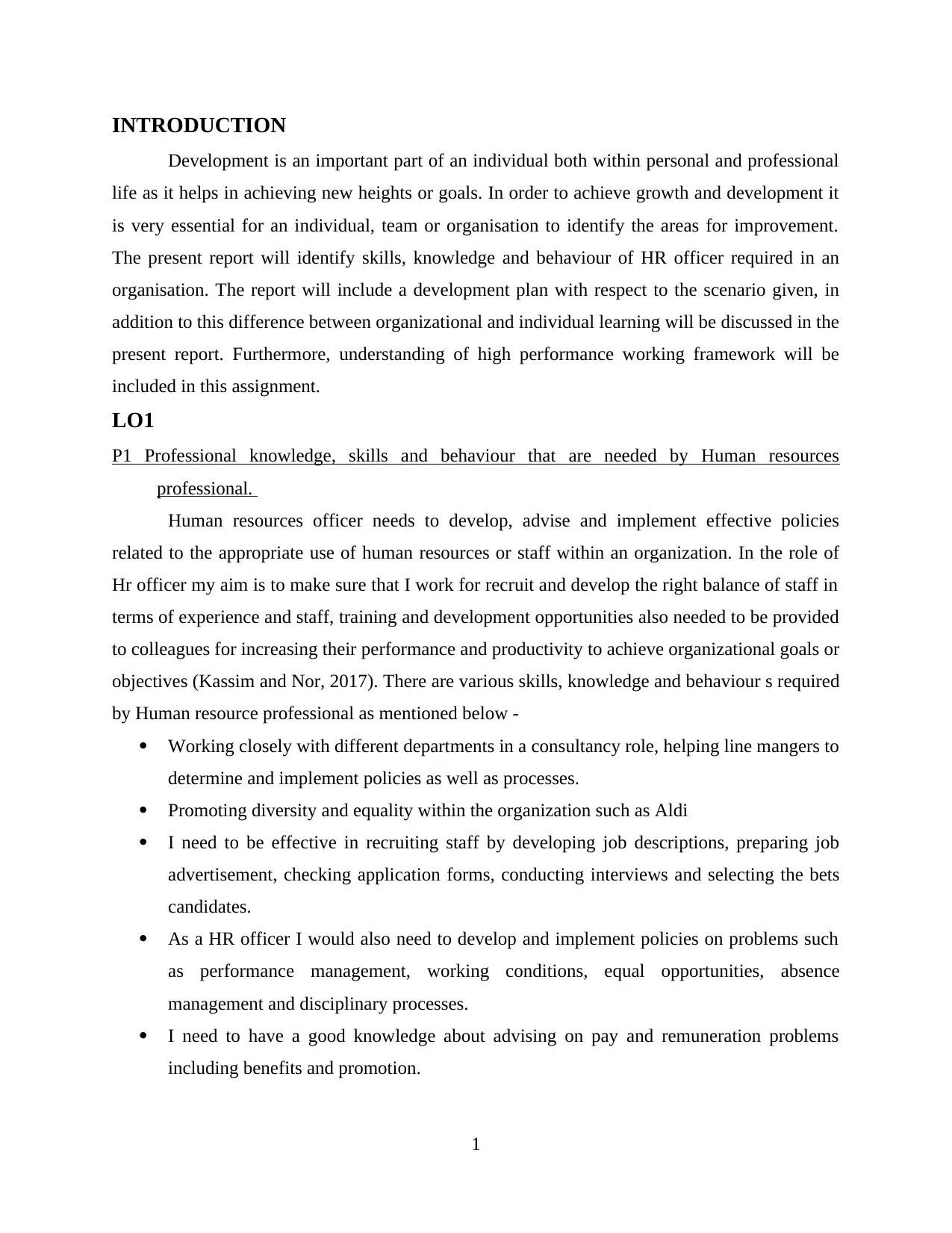
INTRODUCTION
Development is an important part of an individual both within personal and professional
life as it helps in achieving new heights or goals. In order to achieve growth and development it
is very essential for an individual, team or organisation to identify the areas for improvement.
The present report will identify skills, knowledge and behaviour of HR officer required in an
organisation. The report will include a development plan with respect to the scenario given, in
addition to this difference between organizational and individual learning will be discussed in the
present report. Furthermore, understanding of high performance working framework will be
included in this assignment.
LO1
P1 Professional knowledge, skills and behaviour that are needed by Human resources
professional.
Human resources officer needs to develop, advise and implement effective policies
related to the appropriate use of human resources or staff within an organization. In the role of
Hr officer my aim is to make sure that I work for recruit and develop the right balance of staff in
terms of experience and staff, training and development opportunities also needed to be provided
to colleagues for increasing their performance and productivity to achieve organizational goals or
objectives (Kassim and Nor, 2017). There are various skills, knowledge and behaviour s required
by Human resource professional as mentioned below -
Working closely with different departments in a consultancy role, helping line mangers to
determine and implement policies as well as processes.
Promoting diversity and equality within the organization such as Aldi
I need to be effective in recruiting staff by developing job descriptions, preparing job
advertisement, checking application forms, conducting interviews and selecting the bets
candidates.
As a HR officer I would also need to develop and implement policies on problems such
as performance management, working conditions, equal opportunities, absence
management and disciplinary processes.
I need to have a good knowledge about advising on pay and remuneration problems
including benefits and promotion.
1
Development is an important part of an individual both within personal and professional
life as it helps in achieving new heights or goals. In order to achieve growth and development it
is very essential for an individual, team or organisation to identify the areas for improvement.
The present report will identify skills, knowledge and behaviour of HR officer required in an
organisation. The report will include a development plan with respect to the scenario given, in
addition to this difference between organizational and individual learning will be discussed in the
present report. Furthermore, understanding of high performance working framework will be
included in this assignment.
LO1
P1 Professional knowledge, skills and behaviour that are needed by Human resources
professional.
Human resources officer needs to develop, advise and implement effective policies
related to the appropriate use of human resources or staff within an organization. In the role of
Hr officer my aim is to make sure that I work for recruit and develop the right balance of staff in
terms of experience and staff, training and development opportunities also needed to be provided
to colleagues for increasing their performance and productivity to achieve organizational goals or
objectives (Kassim and Nor, 2017). There are various skills, knowledge and behaviour s required
by Human resource professional as mentioned below -
Working closely with different departments in a consultancy role, helping line mangers to
determine and implement policies as well as processes.
Promoting diversity and equality within the organization such as Aldi
I need to be effective in recruiting staff by developing job descriptions, preparing job
advertisement, checking application forms, conducting interviews and selecting the bets
candidates.
As a HR officer I would also need to develop and implement policies on problems such
as performance management, working conditions, equal opportunities, absence
management and disciplinary processes.
I need to have a good knowledge about advising on pay and remuneration problems
including benefits and promotion.
1
⊘ This is a preview!⊘
Do you want full access?
Subscribe today to unlock all pages.

Trusted by 1+ million students worldwide
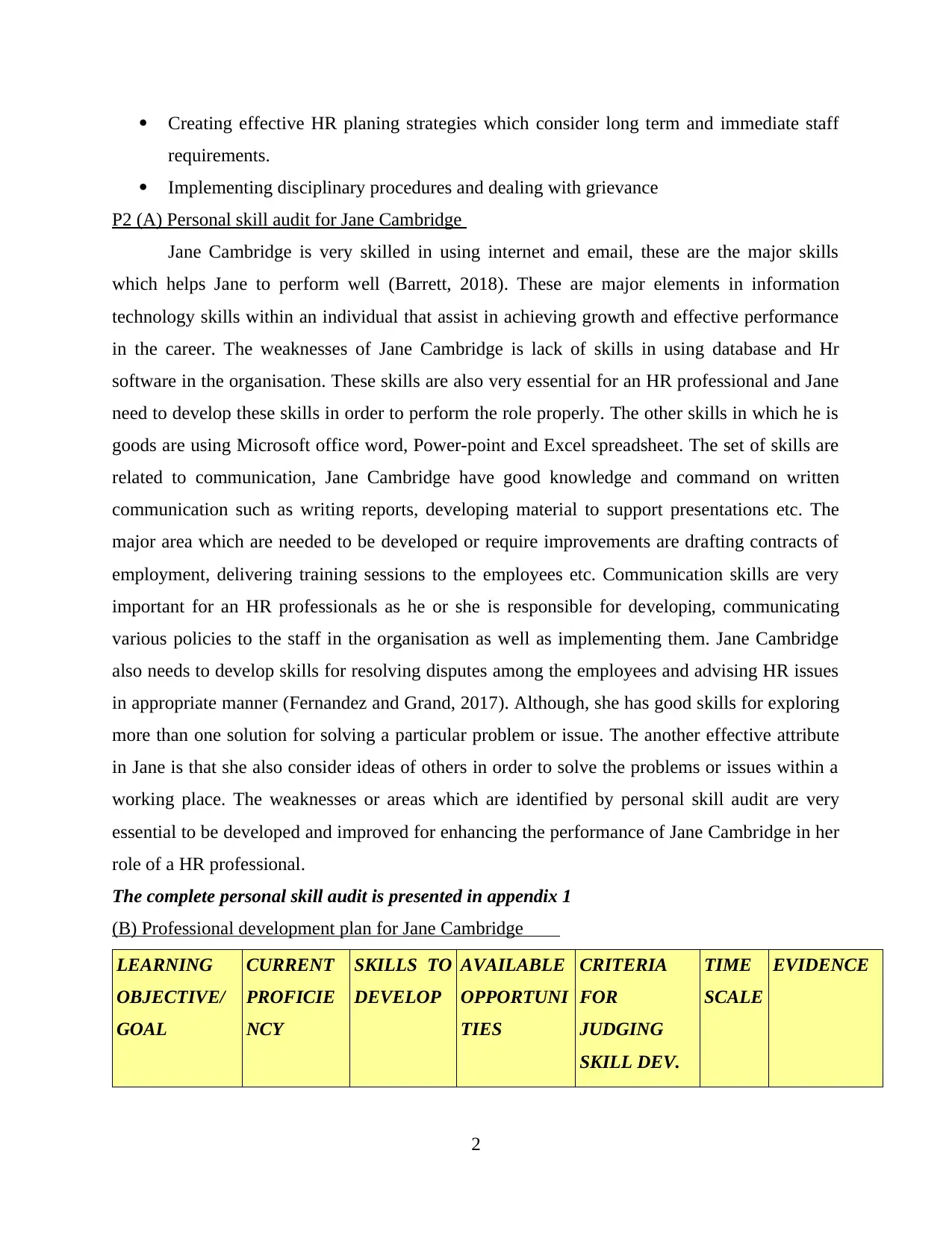
Creating effective HR planing strategies which consider long term and immediate staff
requirements.
Implementing disciplinary procedures and dealing with grievance
P2 (A) Personal skill audit for Jane Cambridge
Jane Cambridge is very skilled in using internet and email, these are the major skills
which helps Jane to perform well (Barrett, 2018). These are major elements in information
technology skills within an individual that assist in achieving growth and effective performance
in the career. The weaknesses of Jane Cambridge is lack of skills in using database and Hr
software in the organisation. These skills are also very essential for an HR professional and Jane
need to develop these skills in order to perform the role properly. The other skills in which he is
goods are using Microsoft office word, Power-point and Excel spreadsheet. The set of skills are
related to communication, Jane Cambridge have good knowledge and command on written
communication such as writing reports, developing material to support presentations etc. The
major area which are needed to be developed or require improvements are drafting contracts of
employment, delivering training sessions to the employees etc. Communication skills are very
important for an HR professionals as he or she is responsible for developing, communicating
various policies to the staff in the organisation as well as implementing them. Jane Cambridge
also needs to develop skills for resolving disputes among the employees and advising HR issues
in appropriate manner (Fernandez and Grand, 2017). Although, she has good skills for exploring
more than one solution for solving a particular problem or issue. The another effective attribute
in Jane is that she also consider ideas of others in order to solve the problems or issues within a
working place. The weaknesses or areas which are identified by personal skill audit are very
essential to be developed and improved for enhancing the performance of Jane Cambridge in her
role of a HR professional.
The complete personal skill audit is presented in appendix 1
(B) Professional development plan for Jane Cambridge
LEARNING
OBJECTIVE/
GOAL
CURRENT
PROFICIE
NCY
SKILLS TO
DEVELOP
AVAILABLE
OPPORTUNI
TIES
CRITERIA
FOR
JUDGING
SKILL DEV.
TIME
SCALE
EVIDENCE
2
requirements.
Implementing disciplinary procedures and dealing with grievance
P2 (A) Personal skill audit for Jane Cambridge
Jane Cambridge is very skilled in using internet and email, these are the major skills
which helps Jane to perform well (Barrett, 2018). These are major elements in information
technology skills within an individual that assist in achieving growth and effective performance
in the career. The weaknesses of Jane Cambridge is lack of skills in using database and Hr
software in the organisation. These skills are also very essential for an HR professional and Jane
need to develop these skills in order to perform the role properly. The other skills in which he is
goods are using Microsoft office word, Power-point and Excel spreadsheet. The set of skills are
related to communication, Jane Cambridge have good knowledge and command on written
communication such as writing reports, developing material to support presentations etc. The
major area which are needed to be developed or require improvements are drafting contracts of
employment, delivering training sessions to the employees etc. Communication skills are very
important for an HR professionals as he or she is responsible for developing, communicating
various policies to the staff in the organisation as well as implementing them. Jane Cambridge
also needs to develop skills for resolving disputes among the employees and advising HR issues
in appropriate manner (Fernandez and Grand, 2017). Although, she has good skills for exploring
more than one solution for solving a particular problem or issue. The another effective attribute
in Jane is that she also consider ideas of others in order to solve the problems or issues within a
working place. The weaknesses or areas which are identified by personal skill audit are very
essential to be developed and improved for enhancing the performance of Jane Cambridge in her
role of a HR professional.
The complete personal skill audit is presented in appendix 1
(B) Professional development plan for Jane Cambridge
LEARNING
OBJECTIVE/
GOAL
CURRENT
PROFICIE
NCY
SKILLS TO
DEVELOP
AVAILABLE
OPPORTUNI
TIES
CRITERIA
FOR
JUDGING
SKILL DEV.
TIME
SCALE
EVIDENCE
2
Paraphrase This Document
Need a fresh take? Get an instant paraphrase of this document with our AI Paraphraser
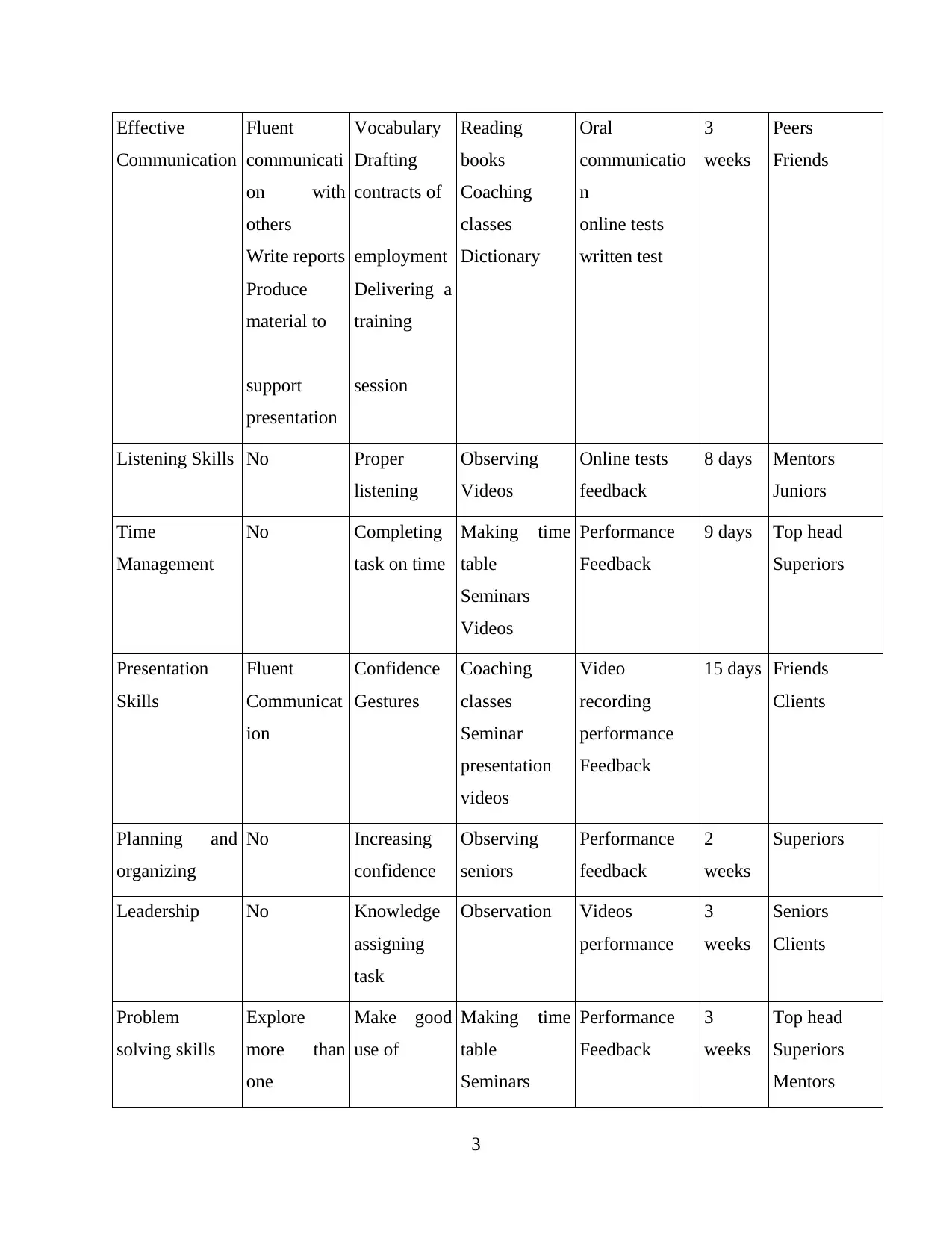
Effective
Communication
Fluent
communicati
on with
others
Write reports
Produce
material to
support
presentation
Vocabulary
Drafting
contracts of
employment
Delivering a
training
session
Reading
books
Coaching
classes
Dictionary
Oral
communicatio
n
online tests
written test
3
weeks
Peers
Friends
Listening Skills No Proper
listening
Observing
Videos
Online tests
feedback
8 days Mentors
Juniors
Time
Management
No Completing
task on time
Making time
table
Seminars
Videos
Performance
Feedback
9 days Top head
Superiors
Presentation
Skills
Fluent
Communicat
ion
Confidence
Gestures
Coaching
classes
Seminar
presentation
videos
Video
recording
performance
Feedback
15 days Friends
Clients
Planning and
organizing
No Increasing
confidence
Observing
seniors
Performance
feedback
2
weeks
Superiors
Leadership No Knowledge
assigning
task
Observation Videos
performance
3
weeks
Seniors
Clients
Problem
solving skills
Explore
more than
one
Make good
use of
Making time
table
Seminars
Performance
Feedback
3
weeks
Top head
Superiors
Mentors
3
Communication
Fluent
communicati
on with
others
Write reports
Produce
material to
support
presentation
Vocabulary
Drafting
contracts of
employment
Delivering a
training
session
Reading
books
Coaching
classes
Dictionary
Oral
communicatio
n
online tests
written test
3
weeks
Peers
Friends
Listening Skills No Proper
listening
Observing
Videos
Online tests
feedback
8 days Mentors
Juniors
Time
Management
No Completing
task on time
Making time
table
Seminars
Videos
Performance
Feedback
9 days Top head
Superiors
Presentation
Skills
Fluent
Communicat
ion
Confidence
Gestures
Coaching
classes
Seminar
presentation
videos
Video
recording
performance
Feedback
15 days Friends
Clients
Planning and
organizing
No Increasing
confidence
Observing
seniors
Performance
feedback
2
weeks
Superiors
Leadership No Knowledge
assigning
task
Observation Videos
performance
3
weeks
Seniors
Clients
Problem
solving skills
Explore
more than
one
Make good
use of
Making time
table
Seminars
Performance
Feedback
3
weeks
Top head
Superiors
Mentors
3

solution in
order to
solve a
problem
Consider the
ideas of
others to
help solve
problems
verbal
reasoning
skills,
able to
handle
complex
data and
make
selective use
of
information
Videos Juniors
Information
Technology
Use the
internet
Use e-mail
Use a
Database
Use
specialist
HR
software
Coaching
classes
Seminar
presentation
videos
Performance
feedback
15 days Top head
Superiors
LO2
P3 The differences between organisational and individual learning, training and development.
Training And Development :- can be defined as an education process which is aimed at
improving knowledge base, skill set, managing attitudes, performance of individual and also
organisation as whole. Training and Development at ALDI ensures that individual is capable
enough to handle the pressure when he is put in the organisational framework.
4
order to
solve a
problem
Consider the
ideas of
others to
help solve
problems
verbal
reasoning
skills,
able to
handle
complex
data and
make
selective use
of
information
Videos Juniors
Information
Technology
Use the
internet
Use e-mail
Use a
Database
Use
specialist
HR
software
Coaching
classes
Seminar
presentation
videos
Performance
feedback
15 days Top head
Superiors
LO2
P3 The differences between organisational and individual learning, training and development.
Training And Development :- can be defined as an education process which is aimed at
improving knowledge base, skill set, managing attitudes, performance of individual and also
organisation as whole. Training and Development at ALDI ensures that individual is capable
enough to handle the pressure when he is put in the organisational framework.
4
⊘ This is a preview!⊘
Do you want full access?
Subscribe today to unlock all pages.

Trusted by 1+ million students worldwide
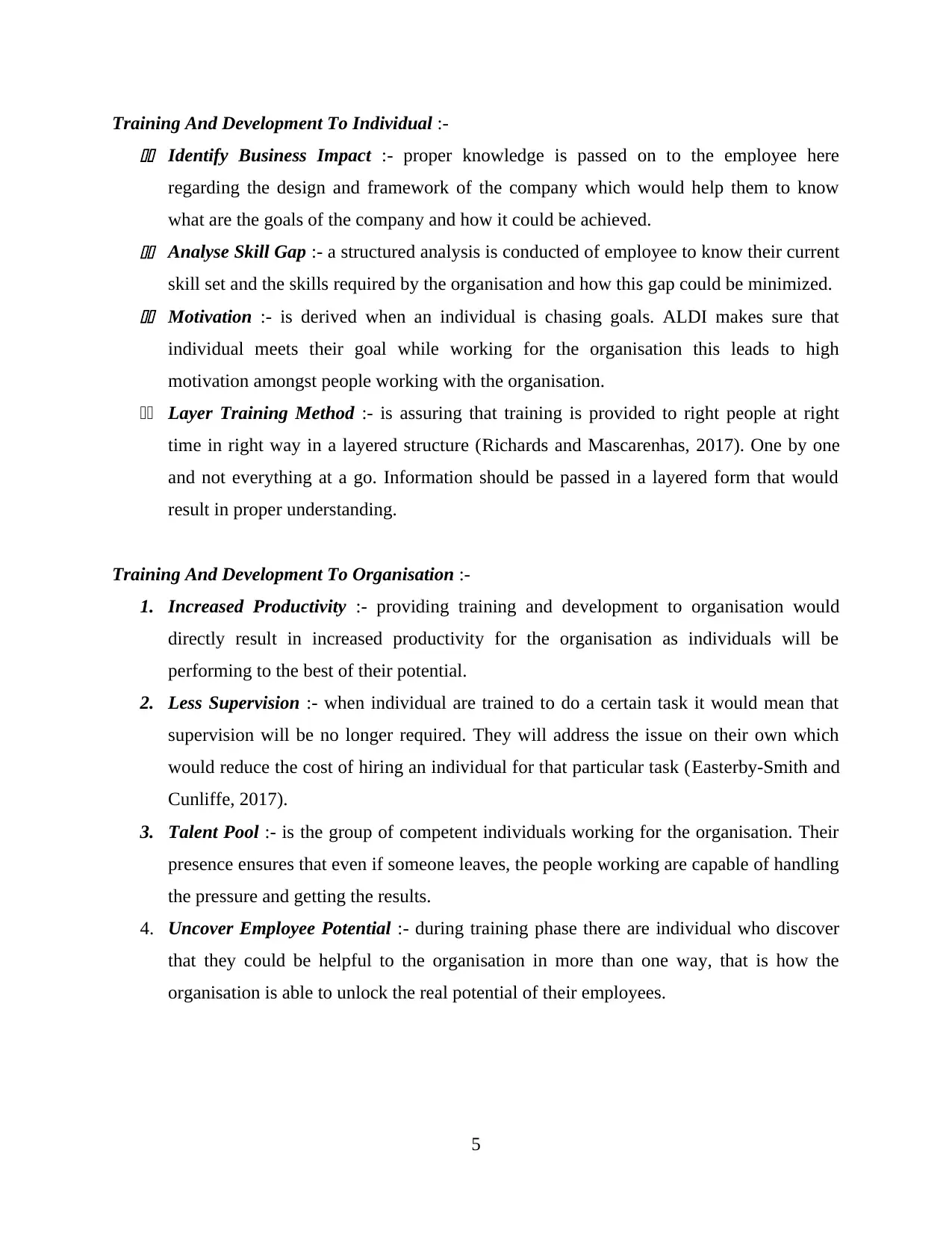
Training And Development To Individual :-11 Identify Business Impact :- proper knowledge is passed on to the employee here
regarding the design and framework of the company which would help them to know
what are the goals of the company and how it could be achieved.11 Analyse Skill Gap :- a structured analysis is conducted of employee to know their current
skill set and the skills required by the organisation and how this gap could be minimized.11 Motivation :- is derived when an individual is chasing goals. ALDI makes sure that
individual meets their goal while working for the organisation this leads to high
motivation amongst people working with the organisation.
11 Layer Training Method :- is assuring that training is provided to right people at right
time in right way in a layered structure (Richards and Mascarenhas, 2017). One by one
and not everything at a go. Information should be passed in a layered form that would
result in proper understanding.
Training And Development To Organisation :-
1. Increased Productivity :- providing training and development to organisation would
directly result in increased productivity for the organisation as individuals will be
performing to the best of their potential.
2. Less Supervision :- when individual are trained to do a certain task it would mean that
supervision will be no longer required. They will address the issue on their own which
would reduce the cost of hiring an individual for that particular task (Easterby-Smith and
Cunliffe, 2017).
3. Talent Pool :- is the group of competent individuals working for the organisation. Their
presence ensures that even if someone leaves, the people working are capable of handling
the pressure and getting the results.
4. Uncover Employee Potential :- during training phase there are individual who discover
that they could be helpful to the organisation in more than one way, that is how the
organisation is able to unlock the real potential of their employees.
5
regarding the design and framework of the company which would help them to know
what are the goals of the company and how it could be achieved.11 Analyse Skill Gap :- a structured analysis is conducted of employee to know their current
skill set and the skills required by the organisation and how this gap could be minimized.11 Motivation :- is derived when an individual is chasing goals. ALDI makes sure that
individual meets their goal while working for the organisation this leads to high
motivation amongst people working with the organisation.
11 Layer Training Method :- is assuring that training is provided to right people at right
time in right way in a layered structure (Richards and Mascarenhas, 2017). One by one
and not everything at a go. Information should be passed in a layered form that would
result in proper understanding.
Training And Development To Organisation :-
1. Increased Productivity :- providing training and development to organisation would
directly result in increased productivity for the organisation as individuals will be
performing to the best of their potential.
2. Less Supervision :- when individual are trained to do a certain task it would mean that
supervision will be no longer required. They will address the issue on their own which
would reduce the cost of hiring an individual for that particular task (Easterby-Smith and
Cunliffe, 2017).
3. Talent Pool :- is the group of competent individuals working for the organisation. Their
presence ensures that even if someone leaves, the people working are capable of handling
the pressure and getting the results.
4. Uncover Employee Potential :- during training phase there are individual who discover
that they could be helpful to the organisation in more than one way, that is how the
organisation is able to unlock the real potential of their employees.
5
Paraphrase This Document
Need a fresh take? Get an instant paraphrase of this document with our AI Paraphraser
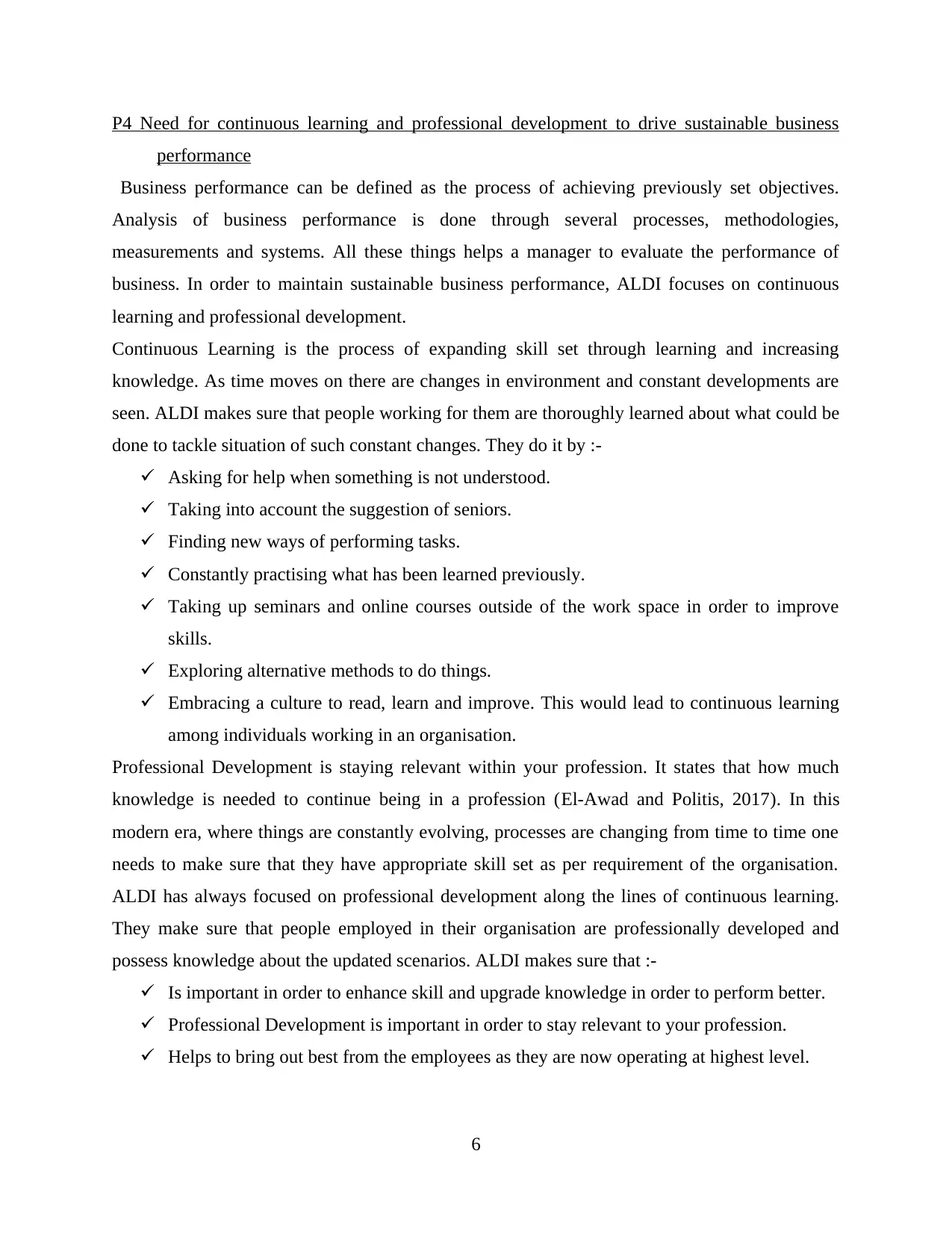
P4 Need for continuous learning and professional development to drive sustainable business
performance
Business performance can be defined as the process of achieving previously set objectives.
Analysis of business performance is done through several processes, methodologies,
measurements and systems. All these things helps a manager to evaluate the performance of
business. In order to maintain sustainable business performance, ALDI focuses on continuous
learning and professional development.
Continuous Learning is the process of expanding skill set through learning and increasing
knowledge. As time moves on there are changes in environment and constant developments are
seen. ALDI makes sure that people working for them are thoroughly learned about what could be
done to tackle situation of such constant changes. They do it by :-
Asking for help when something is not understood.
Taking into account the suggestion of seniors.
Finding new ways of performing tasks.
Constantly practising what has been learned previously.
Taking up seminars and online courses outside of the work space in order to improve
skills.
Exploring alternative methods to do things.
Embracing a culture to read, learn and improve. This would lead to continuous learning
among individuals working in an organisation.
Professional Development is staying relevant within your profession. It states that how much
knowledge is needed to continue being in a profession (El-Awad and Politis, 2017). In this
modern era, where things are constantly evolving, processes are changing from time to time one
needs to make sure that they have appropriate skill set as per requirement of the organisation.
ALDI has always focused on professional development along the lines of continuous learning.
They make sure that people employed in their organisation are professionally developed and
possess knowledge about the updated scenarios. ALDI makes sure that :-
Is important in order to enhance skill and upgrade knowledge in order to perform better.
Professional Development is important in order to stay relevant to your profession.
Helps to bring out best from the employees as they are now operating at highest level.
6
performance
Business performance can be defined as the process of achieving previously set objectives.
Analysis of business performance is done through several processes, methodologies,
measurements and systems. All these things helps a manager to evaluate the performance of
business. In order to maintain sustainable business performance, ALDI focuses on continuous
learning and professional development.
Continuous Learning is the process of expanding skill set through learning and increasing
knowledge. As time moves on there are changes in environment and constant developments are
seen. ALDI makes sure that people working for them are thoroughly learned about what could be
done to tackle situation of such constant changes. They do it by :-
Asking for help when something is not understood.
Taking into account the suggestion of seniors.
Finding new ways of performing tasks.
Constantly practising what has been learned previously.
Taking up seminars and online courses outside of the work space in order to improve
skills.
Exploring alternative methods to do things.
Embracing a culture to read, learn and improve. This would lead to continuous learning
among individuals working in an organisation.
Professional Development is staying relevant within your profession. It states that how much
knowledge is needed to continue being in a profession (El-Awad and Politis, 2017). In this
modern era, where things are constantly evolving, processes are changing from time to time one
needs to make sure that they have appropriate skill set as per requirement of the organisation.
ALDI has always focused on professional development along the lines of continuous learning.
They make sure that people employed in their organisation are professionally developed and
possess knowledge about the updated scenarios. ALDI makes sure that :-
Is important in order to enhance skill and upgrade knowledge in order to perform better.
Professional Development is important in order to stay relevant to your profession.
Helps to bring out best from the employees as they are now operating at highest level.
6
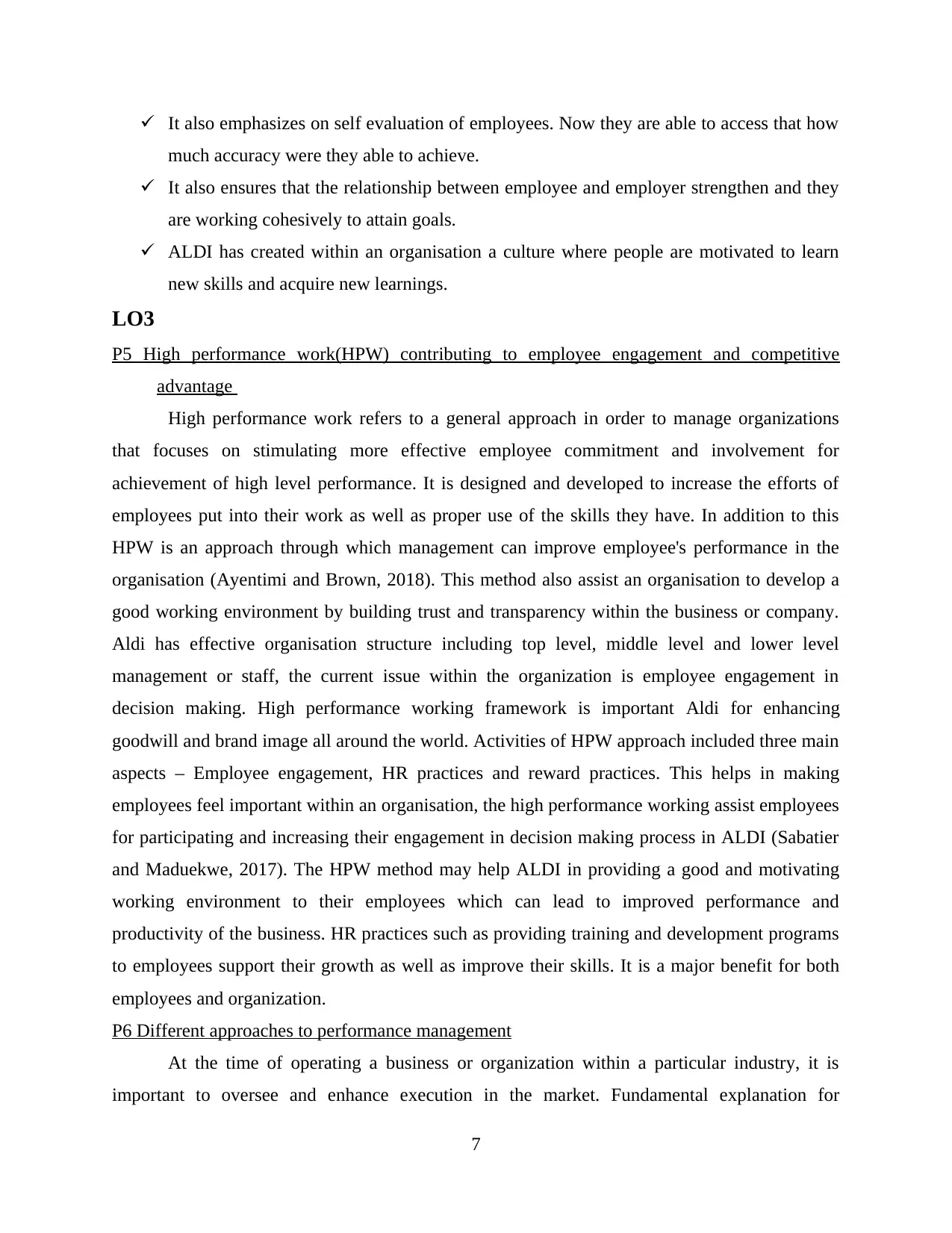
It also emphasizes on self evaluation of employees. Now they are able to access that how
much accuracy were they able to achieve.
It also ensures that the relationship between employee and employer strengthen and they
are working cohesively to attain goals.
ALDI has created within an organisation a culture where people are motivated to learn
new skills and acquire new learnings.
LO3
P5 High performance work(HPW) contributing to employee engagement and competitive
advantage
High performance work refers to a general approach in order to manage organizations
that focuses on stimulating more effective employee commitment and involvement for
achievement of high level performance. It is designed and developed to increase the efforts of
employees put into their work as well as proper use of the skills they have. In addition to this
HPW is an approach through which management can improve employee's performance in the
organisation (Ayentimi and Brown, 2018). This method also assist an organisation to develop a
good working environment by building trust and transparency within the business or company.
Aldi has effective organisation structure including top level, middle level and lower level
management or staff, the current issue within the organization is employee engagement in
decision making. High performance working framework is important Aldi for enhancing
goodwill and brand image all around the world. Activities of HPW approach included three main
aspects – Employee engagement, HR practices and reward practices. This helps in making
employees feel important within an organisation, the high performance working assist employees
for participating and increasing their engagement in decision making process in ALDI (Sabatier
and Maduekwe, 2017). The HPW method may help ALDI in providing a good and motivating
working environment to their employees which can lead to improved performance and
productivity of the business. HR practices such as providing training and development programs
to employees support their growth as well as improve their skills. It is a major benefit for both
employees and organization.
P6 Different approaches to performance management
At the time of operating a business or organization within a particular industry, it is
important to oversee and enhance execution in the market. Fundamental explanation for
7
much accuracy were they able to achieve.
It also ensures that the relationship between employee and employer strengthen and they
are working cohesively to attain goals.
ALDI has created within an organisation a culture where people are motivated to learn
new skills and acquire new learnings.
LO3
P5 High performance work(HPW) contributing to employee engagement and competitive
advantage
High performance work refers to a general approach in order to manage organizations
that focuses on stimulating more effective employee commitment and involvement for
achievement of high level performance. It is designed and developed to increase the efforts of
employees put into their work as well as proper use of the skills they have. In addition to this
HPW is an approach through which management can improve employee's performance in the
organisation (Ayentimi and Brown, 2018). This method also assist an organisation to develop a
good working environment by building trust and transparency within the business or company.
Aldi has effective organisation structure including top level, middle level and lower level
management or staff, the current issue within the organization is employee engagement in
decision making. High performance working framework is important Aldi for enhancing
goodwill and brand image all around the world. Activities of HPW approach included three main
aspects – Employee engagement, HR practices and reward practices. This helps in making
employees feel important within an organisation, the high performance working assist employees
for participating and increasing their engagement in decision making process in ALDI (Sabatier
and Maduekwe, 2017). The HPW method may help ALDI in providing a good and motivating
working environment to their employees which can lead to improved performance and
productivity of the business. HR practices such as providing training and development programs
to employees support their growth as well as improve their skills. It is a major benefit for both
employees and organization.
P6 Different approaches to performance management
At the time of operating a business or organization within a particular industry, it is
important to oversee and enhance execution in the market. Fundamental explanation for
7
⊘ This is a preview!⊘
Do you want full access?
Subscribe today to unlock all pages.

Trusted by 1+ million students worldwide

estimating this angle is that, it realizes that ALDI has which sort of execution like expanding or
diminishing in industry of supermarkets. Based on this, management of chosen organization
makes effective activities and apply different systems which help to support up execution in cited
industry. There are extensive variety of methodologies and systems accessible through which
business performance appropriately and takes decisions as needed. There are various approaches
for the management of performance as described below - Behavioural approach: This approach is one of the most seasoned strategy of execution
estimation. Conduct approach is additionally reasonable for intelligibility and precision.
It is most critical approach in the picked association, in light of the fact that an uplifting
state of mind is exceptionally fundamental in association. On the off chance that An
employee of ALDI have an inspirational state of mind than he can fulfill the clients
(Steinbach and Cannella, 2017). An employee ought to dependably convey a decent and
quiet nature. Its employee's obligation to welcome their client extremely well, they
should in charge of their obligation. An employee should endeavor to take care of clients
issue when they can, employees ought to have a decent summon on their way of talking. Comparative approach: Second approach in which correlation among two or gatherings
is made and based on this level of execution is to be surveyed. Aside from this, over a
wide span of time information additionally can be estimated and overseen according to
the present system. Further, once in a while positions additionally given to the gatherings
based on most elevated and least entertainer (Ranjan, 2017). For instance: One group
gives finishes specific undertaking in two days and another entire the same in three days.
Consequently, first gathering will be considered very effective when contrasted with
second. In this, administration of ALDI will make procedures to build productivity of
second group of individuals.
Quality approach: Apart from conduct and relative methodologies of execution
administration, quality approach is additionally exceptionally successful critical. As
indicated by this, fundamentally fulfillment level of clients are considered based on
nature of items and administrations offered by ALDI. According to this, workers or
individuals take input on regularly by analyzing mistakes and errors acquired in task
division (Rao and Jacobson, 2017). Keeping in mind the end goal to apply this particular
8
diminishing in industry of supermarkets. Based on this, management of chosen organization
makes effective activities and apply different systems which help to support up execution in cited
industry. There are extensive variety of methodologies and systems accessible through which
business performance appropriately and takes decisions as needed. There are various approaches
for the management of performance as described below - Behavioural approach: This approach is one of the most seasoned strategy of execution
estimation. Conduct approach is additionally reasonable for intelligibility and precision.
It is most critical approach in the picked association, in light of the fact that an uplifting
state of mind is exceptionally fundamental in association. On the off chance that An
employee of ALDI have an inspirational state of mind than he can fulfill the clients
(Steinbach and Cannella, 2017). An employee ought to dependably convey a decent and
quiet nature. Its employee's obligation to welcome their client extremely well, they
should in charge of their obligation. An employee should endeavor to take care of clients
issue when they can, employees ought to have a decent summon on their way of talking. Comparative approach: Second approach in which correlation among two or gatherings
is made and based on this level of execution is to be surveyed. Aside from this, over a
wide span of time information additionally can be estimated and overseen according to
the present system. Further, once in a while positions additionally given to the gatherings
based on most elevated and least entertainer (Ranjan, 2017). For instance: One group
gives finishes specific undertaking in two days and another entire the same in three days.
Consequently, first gathering will be considered very effective when contrasted with
second. In this, administration of ALDI will make procedures to build productivity of
second group of individuals.
Quality approach: Apart from conduct and relative methodologies of execution
administration, quality approach is additionally exceptionally successful critical. As
indicated by this, fundamentally fulfillment level of clients are considered based on
nature of items and administrations offered by ALDI. According to this, workers or
individuals take input on regularly by analyzing mistakes and errors acquired in task
division (Rao and Jacobson, 2017). Keeping in mind the end goal to apply this particular
8
Paraphrase This Document
Need a fresh take? Get an instant paraphrase of this document with our AI Paraphraser

approach in the work environment of ALDI, Kaizen approach is utilized. Through this,
administration ready to enhance nature of products and services on predictable basis.
CONCLUSION
The above report concluded that development of individuals, team and organization is
very essential in each and every organization for achieving the goals or objective easily. The
report knowledge, skills and behaviour required by a Human resource officer. The report also
identified various approaches to performance management and need for continuous learning and
professional development.
9
administration ready to enhance nature of products and services on predictable basis.
CONCLUSION
The above report concluded that development of individuals, team and organization is
very essential in each and every organization for achieving the goals or objective easily. The
report knowledge, skills and behaviour required by a Human resource officer. The report also
identified various approaches to performance management and need for continuous learning and
professional development.
9

REFERENCES
Books and journals
Kassim, N.A. and Nor, A.M., 2017. Team learning in a learning organization: The practices of
team learning among university librarians in Malaysia. Malaysian Journal of Library &
Information Science, 12(1), pp.55-64.
Barrett, J., 2018. Sustainable organizations in health and social care: developing a" team mind".
In Containment in the Community (pp. 45-67). Routledge.
Fernandez, R., Shah, S., Rosenman, E.D., Kozlowski, S.W., Parker, S.H. and Grand, J.A., 2017.
Developing team cognition: A role for simulation. Simulation in healthcare: journal of
the Society for Simulation in Healthcare, 12(2), p.96.
Richards, P., Collins, D. and Mascarenhas, D.R., 2017. Developing team decision-making: a
holistic framework integrating both on-field and off-field pedagogical coaching
processes. Sports Coaching Review, 6(1), pp.57-75.
Easterby-Smith, M. and Cunliffe, A.L., 2017. From reflection to practical reflexivity:
Experiential learning as lived experience. In Organizing reflection (pp. 44-60).
Routledge.
El-Awad, Z., Gabrielsson, J. and Politis, D., 2017. Entrepreneurial learning and innovation: The
critical role of team-level learning for the evolution of innovation capabilities in
technology-based ventures. International Journal of Entrepreneurial Behavior &
Research, 23(3), pp.381-405. O'Neill, T.A. and McLarnon, M.J., 2017. Optimizing team
conflict dynamics for high performance teamwork. Human Resource Management
Review.
Ayentimi, D.T., Burgess, J. and Brown, K., 2018. A conceptual framework for international
human resource management research in developing economies. Asia Pacific Journal of
Human Resources, 56(2), pp.216-237.
Steinbach, A.L., Holcomb, T.R., Holmes Jr, R.M., Devers, C.E. and Cannella Jr, A.A., 2017. Top
management team incentive heterogeneity, strategic investment behavior, and
performance: A contingency theory of incentive alignment. Strategic Management
Journal, 38(8), pp.1701-1720.
Ranjan, P., 2017. Human Resource Management and Organizational Behaviour. Journal of HR,
Organizational Behaviour & Entrepreneurship Development, 1(1), pp.8-12.
10
Books and journals
Kassim, N.A. and Nor, A.M., 2017. Team learning in a learning organization: The practices of
team learning among university librarians in Malaysia. Malaysian Journal of Library &
Information Science, 12(1), pp.55-64.
Barrett, J., 2018. Sustainable organizations in health and social care: developing a" team mind".
In Containment in the Community (pp. 45-67). Routledge.
Fernandez, R., Shah, S., Rosenman, E.D., Kozlowski, S.W., Parker, S.H. and Grand, J.A., 2017.
Developing team cognition: A role for simulation. Simulation in healthcare: journal of
the Society for Simulation in Healthcare, 12(2), p.96.
Richards, P., Collins, D. and Mascarenhas, D.R., 2017. Developing team decision-making: a
holistic framework integrating both on-field and off-field pedagogical coaching
processes. Sports Coaching Review, 6(1), pp.57-75.
Easterby-Smith, M. and Cunliffe, A.L., 2017. From reflection to practical reflexivity:
Experiential learning as lived experience. In Organizing reflection (pp. 44-60).
Routledge.
El-Awad, Z., Gabrielsson, J. and Politis, D., 2017. Entrepreneurial learning and innovation: The
critical role of team-level learning for the evolution of innovation capabilities in
technology-based ventures. International Journal of Entrepreneurial Behavior &
Research, 23(3), pp.381-405. O'Neill, T.A. and McLarnon, M.J., 2017. Optimizing team
conflict dynamics for high performance teamwork. Human Resource Management
Review.
Ayentimi, D.T., Burgess, J. and Brown, K., 2018. A conceptual framework for international
human resource management research in developing economies. Asia Pacific Journal of
Human Resources, 56(2), pp.216-237.
Steinbach, A.L., Holcomb, T.R., Holmes Jr, R.M., Devers, C.E. and Cannella Jr, A.A., 2017. Top
management team incentive heterogeneity, strategic investment behavior, and
performance: A contingency theory of incentive alignment. Strategic Management
Journal, 38(8), pp.1701-1720.
Ranjan, P., 2017. Human Resource Management and Organizational Behaviour. Journal of HR,
Organizational Behaviour & Entrepreneurship Development, 1(1), pp.8-12.
10
⊘ This is a preview!⊘
Do you want full access?
Subscribe today to unlock all pages.

Trusted by 1+ million students worldwide
1 out of 15
Related Documents
Your All-in-One AI-Powered Toolkit for Academic Success.
+13062052269
info@desklib.com
Available 24*7 on WhatsApp / Email
![[object Object]](/_next/static/media/star-bottom.7253800d.svg)
Unlock your academic potential
Copyright © 2020–2025 A2Z Services. All Rights Reserved. Developed and managed by ZUCOL.





